General anesthesia is a procedure by which a person is put into sleep like state for the performance of surgery or other painful medical procedures.
Although anesthesia was used throughout history, in primitive forms, to help in performing surgeries, the world was introduced to what is general anesthesia for the first time in 1844. It was when Horace Wells, a dentist from Hartford in the USA, used nitrous oxide for a painless tooth extraction.
 Nitrous oxide the first general anesthetic was discovered by Priestley in 1776. General Anesthesia was demonstrated for the first time by Morton, a second year medical student in 1846. He successfully showed the use of ether as a general anesthetic in the first classic demonstration done in the operating room of the Massachusetts General Hospital in Boston, USA.
Nitrous oxide the first general anesthetic was discovered by Priestley in 1776. General Anesthesia was demonstrated for the first time by Morton, a second year medical student in 1846. He successfully showed the use of ether as a general anesthetic in the first classic demonstration done in the operating room of the Massachusetts General Hospital in Boston, USA.
Anesthesiology has since then developed very rapidly and now many safe general anesthesia drugs are available for use.
General anesthetics are the agents which cause loss of all modes of sensation, particularly pain, along with a reversible loss of consciousness. Local anesthetics abolish the pain sensation, without affecting consciousness, in localized areas. repliki zegarków
Anesthesia is broadly classified as general anesthesia and regional anesthesia.
Regional anesthesia also called as local anesthesia consists of Neuraxial anesthesia and peripheral nerve block anesthesia.
What are general anesthetic drugs or medicines?
 The general anesthetic drugs are classified as:
The general anesthetic drugs are classified as:
Inhalation general anesthetics:
- Volatile anesthesia drugs: Chloroform, Ethyl chloride, Diethyl ether, Trichloroethylene, Halothane, Sevoflurane, Enflurane, desflurane, and Isoflurane.
- Gases: Cyclopropane and Nitrous oxide.
Cyclopropane and Chloroform are not in use now.
 Nonvolatile general anesthetics (Intravenous anesthetics):
Nonvolatile general anesthetics (Intravenous anesthetics):
- Barbiturates: Sodium Thiopental (Thiopental)
- Etomidate, Propofol.
- Benzodiazepine: Midazolam, Diazepam
- Phencyclidine derivative: Ketamine
- Steroid: Pregnenolone.
How does general anesthesia work?
The general anesthesia mechanism of action and site of action varies with the general anesthetic medicine. The general anesthesia drugs are capable of depressing all the functional elements of the CNS including the spinal cord.
To understand the question ‘how does general anesthesia work’ anesthesiologists and scientists studied which part of the brain is affected by anesthesia. replica horloges
The effect of these anesthetic drugs varies according to their chemical structure and also due to their ability to act at different sites of the central nervous system and act on target areas. For example, special areas in the cortex of the brain exhibit different sensitivities to inhalational and intravenous anesthesia drugs.
Inhibition of motor response to pain, like that from the surgical incision, is mediated from the spinal cord. The general anesthetics by inhibiting the spinal cord activity, decrease the transmission of painful stimuli that ascend from the spinal cord to the brain and hence decrease arousal of supra spinal centers.
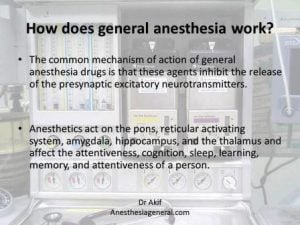 The anesthetics also suppress the descending signals from the brain and result in immobilization. In the brain, anesthetic medications depress blood flow throughout and also the glucose metabolism. They change the neurotransmission selectively in many areas of the brain suppressing the electrical activity.
The anesthetics also suppress the descending signals from the brain and result in immobilization. In the brain, anesthetic medications depress blood flow throughout and also the glucose metabolism. They change the neurotransmission selectively in many areas of the brain suppressing the electrical activity.
They affect behavior by direct action on the brain and also cause amnesia and hypnosis.
Specific sites in the brain where general anesthesia drugs act are not exactly established by evidence. It has been proposed the multiple sites are involved.
Anesthetics act on the pons, reticular activating system, amygdala, hippocampus, and the thalamus and affect the attentiveness, cognition, sleep, learning, memory, and attentiveness of a person.
One GABA modulated region called the Tuberomammillary nucleus of the hypothalamus which regulated sleep is also a site of action of some sedatives.
It was believed until recently, that there is only one mechanism of action for all the structurally different general anesthesia medicines. This theory was consistent with the observation by Overton and Meyer that there is a close correlation between lipid solubility and the potency of an anesthetic drug.
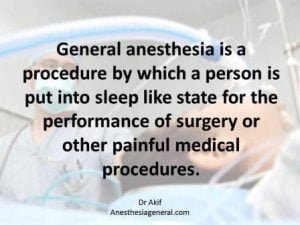 This observation caused the formation of the theory that anesthetic drugs act nonspecifically on hydrophobic lipid component of cells. However, current evidence suggests that molecular targets for general anesthetic medicines are primarily proteins of the ion channels of the nerves.
This observation caused the formation of the theory that anesthetic drugs act nonspecifically on hydrophobic lipid component of cells. However, current evidence suggests that molecular targets for general anesthetic medicines are primarily proteins of the ion channels of the nerves.
The major channels associated with nicotinic receptors, receptors for glutamate and glycine, 5-HT receptors, and GABA-A receptors are the binding sites for anesthetic medications and agents. The specific receptors vary from one anesthetic drug to another e.g. nicotinic receptors or NMDA for nitrous oxide; GABA-A for most IV anesthetics; and NMDA for ketamine.
The common mechanism of action of general anesthesia drugs is that these agents inhibit the release of the presynaptic excitatory neurotransmitters.
Anesthetics also change the postsynaptic responsiveness to released neurotransmitters by increasing the activity offer inhibitory ion channels in post-synaptic receptors by enhancing inhibitory neurotransmission within CNS.
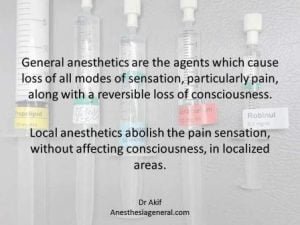 The highly soluble anesthetic agents such as diethyl ether have a slow induction, recovery, and change of depth of anesthesia.
The highly soluble anesthetic agents such as diethyl ether have a slow induction, recovery, and change of depth of anesthesia.
Inhalation General Anesthetic’s mixture, in the arterial and mixed venous blood, and in the tissues is influenced by the rate of blood flow. The solubility of these agents in blood is proportional to the partial pressure in the lungs.
Specific behavioral effects of an anesthetic are attributable to the selectivity of ion channel it is acting on.
The general anesthetics have therapeutic indices that vary from 2 to 4. This means that they have a very low margin of safety. replika órák
 Minimum Alveolar Concentration or MAC
Minimum Alveolar Concentration or MAC
It is usually difficult to estimate the dose of general anesthesia agents accurately. The potency of inhalation general anesthetics is measured by Minimum Alveolar Concentration (MAC).
Minimum Alveolar Concentration or MAC of an anesthetic agent is the amount of inhalation agent that stops the movement of a person in response to the surgical incision, at one atmospheric pressure.
Most of the time, 0.5 to 2 MAC are required for adequate anesthesia. The MAC required for halothane is 0.75 and that of enflurane is 1.68. Nitrous oxide has a MAC of 105. Thus, nitrous oxide used as a sole anesthetic has a poor effect.
Methods of administration of inhalational general anesthesia
1) Open general anesthesia method
Open general anesthesia is a simple method of administering a volatile anesthetic and the also the oldest.
A simple face mask like Schimmelbusch mask is covered with about 6 to 10 layers of gauze pieces, which does not fit the shape of the face.
An older generation of general anesthetics like ethyl chloride or ether is poured on it in drops after it is held in the face. Therefore this is also called as the ‘open drop’ procedure. It was used historically during the time ether was used for anesthesia.
The open general anesthesia technique does not need any special anesthesia machine. The anesthetic agent is evaporated and forms the vapor which is diluted with air and is inhaled through the gap between the anesthesia mask and the face. There is no rebreathing in this technique.
 2) Semi-open general anesthesia method
2) Semi-open general anesthesia method
The semi-open general anesthesia method is similar to open method but the dilution with air is prevented by using either layer of gauze between face or the mask or a well-fitting mask like Ogston’s mask. A bit of carbon dioxide build-up occurs with this method.
3) Semi-closed general anesthesia method
The semi-closed method allows some rebreathing of the anesthetic drug with the help of a reservoir. It involved breathing through a circuit for inspiration and expiration but is not closed completely. Also, part of the volume of each succeeding inspiration is a new portion of an anesthetic mixture. This method involves accumulation and rebreathing of carbon dioxide.
4) Closed general anesthesia method
The closed method for giving general anesthesia usually employs the chemical agent soda lime to reabsorb the carbon dioxide present in the expired air. It requires the use of a complicated anesthesia machine but is particularly useful when the general anesthetic drug is potentially explosive. The delivery of anesthesia is through a completely closed circuit with a minimal fresh gas flow.
4 Stages of General Anesthesia
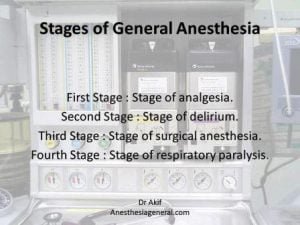 There are 4 stages of General Anesthesia. Guedel, in 1920, referring mainly to the anesthetic drug ether, described the four stages of general anesthesia and divided the third stage of surgical anesthesia into four different planes. These stages can be distinctly discerned with the majority of the volatile general anesthetics. The 4 stages of general anesthesia are:
There are 4 stages of General Anesthesia. Guedel, in 1920, referring mainly to the anesthetic drug ether, described the four stages of general anesthesia and divided the third stage of surgical anesthesia into four different planes. These stages can be distinctly discerned with the majority of the volatile general anesthetics. The 4 stages of general anesthesia are:
First Stage of General Anesthesia: Stage of analgesia.
Second Stage of General Anesthesia: Stage of delirium.
Third Stage of General Anesthesia: Stage of surgical anesthesia.
Fourth Stage of General Anesthesia: Stage of respiratory paralysis.
1) Stage of Analgesia:
This stage stretches from the beginning of inhalation of the general anesthetic to loss of consciousness.
The gradual depression of the cortical centers occurs during this phase of general anesthesia. This is manifested as a sensation of remoteness, falling, suffocation or as visual or auditory aberrations. A feeling of warmth is experienced by some individuals.
Analgesia is produced before consciousness is lost. Minor surgical procedures such as incision of an abscess, dental extraction, and obstetrical maneuvers can be carried out successfully during this stage of general anesthesia. However, it is difficult to maintain it for a long time. The patient rapidly passes into the second stage, the stage of delirium.
2) Stage of Delirium or Excitement:
This stage extends from the loss of consciousness to the beginning of surgical anesthesia. It may be associated with excitement, shouting, increased muscular activity, breath holding, tachypnea, and hyperventilation.
Some of these manifestations are due to release of the lower centers from the inhibitory control of higher centers as a result of cortical depression.
The pupils may dilate and marked hypertension and tachycardia may develop, due to the release of adrenaline.
Struggling, increased the tone of the skeletal muscles, retching and vomiting are the undesirable features of this stage. They can be minimized by proper pre-anesthetic medication.
3) Stage of Surgical Anesthesia:
As more drug gets in, deep breathing starts and the patient passes into the third stage. It is characterized by a gradual loss of reflexes, regular respiration and relaxation of the skeletal muscles.
Reflex activity is lost. This stage is usually employed for surgical intervention and is divided into four planes.
Plane 1:
The pupils dilate progressively with the depth of general anesthesia. The respiration is full, regular, deep and of thoracoabdominal character.
The blood pressure and the pulse rate are normal. The skeletal muscles are in completely relaxed.
The lid reflex, swallowing, retching and vomiting get abolished. The corneal reflex is present but the conjunctival reflex is lost. The loss of pharyngeal reflex in the middle of this plane enables the anesthesiologist to pass an oral or nasal pharyngeal airway.
Plane 2:
The respiratory excursions are regular but the amplitude is diminished. Muscular relaxation is adequate. Reflexes arising from the larynx are also abolished and endotracheal intubation can be performed.
Plane 3:
This is characterized by the beginning of asynchrony between the thoracic and the abdominal respiratory movements.
The blood pressure begins to fall, the intercostal muscles are gradually paralyzed and the respiration assumes an increasingly abdominal character. The pupillary light reflex and the corneal reflex are lost. The muscular relaxation is essentially complete.
Plane 4:
The paralysis of the intercostal muscles is complete, the pupils are dilated, do not respond to light, the muscles are flaccid and the blood pressure is low. The secretions are completely abolished.
4) Stage of Respiratory Paralysis:
This stage is characterized by severe depression of the vital medullary centers. Eventually, respiratory arrest with the paralysis of accessory muscles and diaphragm supervenes. This is accompanied by vasomotor collapse and cardiac arrest.
The stages described here may differ considerably with different anesthetic drugs. Halothane produces hypotension much more readily than ether. Pupillary dilatation is a progressive and reliable sign with ether while it is insignificant with halothane.
With ether, the skin becomes pale, cold and wet in the preparalytic stage while with halothane, it is warm and dry until the development of marked hypotension.
Preanaesthetic medication with the opioid analgesics, atropine and the use of skeletal muscle relaxants also modifies the signs of the anesthesia and may interfere with the proper assessment of the depth of anesthesia.
In modern anesthetic practice, the stages are never discerned separately because a combination of agents (balanced anesthesia) is used. Every effort is made to achieve a rapid and smooth induction, avoiding the stage of delirium with the help of IV inducing drugs such as thiopental.
Inadequate general anesthesia
Inadequate anesthesia is identified by
- Signs of Autonomic Nervous system (ANS) over activity, such as tachycardia, a rise of BP, sweating, and lacrimation.
- Grimacing
- Any muscle movement
 Surgical anesthesia
Surgical anesthesia
Surgical anesthesia is indicated by
- Loss of eyelash (lid) reflex; and
- Development of rhythmic respiration.
Deep general anesthesia
Deep general anesthesia is characterized by:
- Depression of respiration.
- Marked hypotension; and
- Associated blood loss and hypoxia can aggravate the situation. They must be avoided.
- With agents such as halothane, hypotension can be used as an index of dosage.
If you have any question on anesthesia or any other health related issue you can Ask a Doctor at Ask Doctor .org

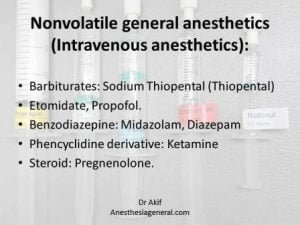 Nonvolatile general anesthetics (Intravenous anesthetics):
Nonvolatile general anesthetics (Intravenous anesthetics):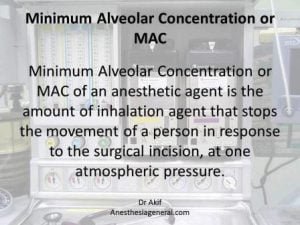 Minimum Alveolar Concentration or MAC
Minimum Alveolar Concentration or MAC 2) Semi-open general anesthesia method
2) Semi-open general anesthesia method Surgical anesthesia
Surgical anesthesia